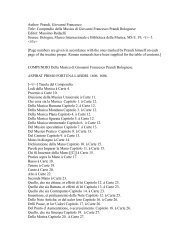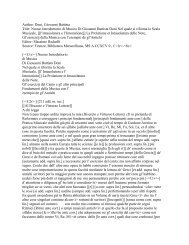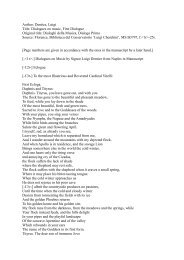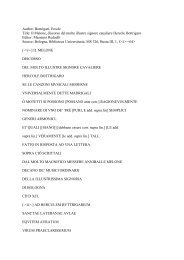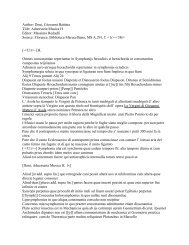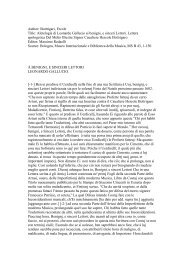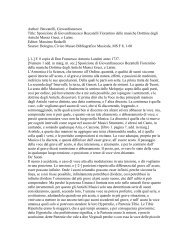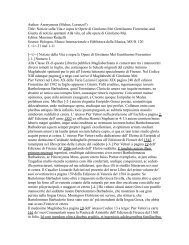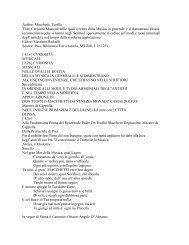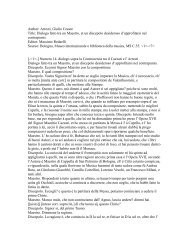Author: Doni, Giovanni Battista - manuscripts of italian music theory ...
Author: Doni, Giovanni Battista - manuscripts of italian music theory ...
Author: Doni, Giovanni Battista - manuscripts of italian music theory ...
You also want an ePaper? Increase the reach of your titles
YUMPU automatically turns print PDFs into web optimized ePapers that Google loves.
On the specific differences <strong>of</strong> these three genera chapter<br />
From the division <strong>of</strong> each genus which we have seen made in the tetrachords one can<br />
say very probably that the difference and hallmarks <strong>of</strong> these three sorts <strong>of</strong> melody<br />
consists in this: in the Diatonic, the fact that there are two adjacent tones; in the<br />
chromatic, that there are two semitones, and in the Enharmonic, that there are two<br />
Diesis. I mean that this happens in that type <strong>of</strong> Harmony which uses equal intervals,<br />
as it is the case in the lute and in the viol, [--] and in which the ancients give<br />
their examples, albeit in practice then, as we will see, the perfect harmony was used,<br />
namely the one which distinguishes between larger and smaller tones and semitones.<br />
In this Harmony the larger Semitone indicates the Diatonic, because it is its smallest<br />
interval, and for the same reason the smallest Semitone is indicative <strong>of</strong> the Chromatic,<br />
and the Diesis <strong>of</strong> the Enharmonic. In fact, the Chromatic does not accept the diesis<br />
(which we always understand as enharmonic) nor the Diatonic does accept it, nor the<br />
minor semitone. However, if we consider the third interval, which is the largest and<br />
highest, equally we can say that the tone belongs specifically to the Diatonic, the<br />
Semiditono to the Chromatic and the Ditone to the Enharmonic. We can also say that<br />
the Diatessaron denotes the Diatonic in particular, not so much because one finds in it<br />
those three intervals which derive from the first division <strong>of</strong> the last consonance <strong>of</strong> the<br />
Ditone and Semiditone, namely, by dividing the Ditone firstly into larger and smaller<br />
Tone and the Semiditione into major Tone and major Semitone, I say, not so much for<br />
this reason, as Salinas maintains, but because the diatessaron was the smallest<br />
consonance at the time when the Diatonic was the only known genus. I really hold for<br />
certain that the fact that Chromatic and the Enarmonic began to be used generated the<br />
opportunity to use the Ditone and Semiditone as consonances (albeit perhaps they did<br />
not call them as such) [--] and to know them as such with the aid <strong>of</strong> the ear. I am<br />
drawn to believe, because it is very plausible, that the larger Semitone was introduced<br />
in singing when these two genera were first used, and it was introduced undivided in<br />
the Chromatic and divided in the Enharmonic. From this it follows, consequently, that<br />
the remaining part <strong>of</strong> the tetrachord is a ditone, that is really a consonance and is<br />
composed by adding the smaller semitone to the larger, and the result is the<br />
semiditone which is also consonant, while, as I said above, the two genera, which one<br />
maintains that were sung in those most ancient times, were not suited to it very well.<br />
Now, since the chromatic is based on the larger Tone and the Enharmonic on the<br />
smaller Semitone, I do not know how to square this with what concerns the chromatic,<br />
since, if we divide the larger tone into two semitones, what is left over is a minor third<br />
shortened by a comma, and therefore dissonant. I believe that that division does not<br />
suit the Chromatic, otherwise a consonance, which is its own, would be taken away.<br />
Since the larger semitone and the smaller one, as Zarlino demonstrates very well<br />
make up the smaller Tone and not the larger, why should one base the chromatic<br />
genus more in this one than in that one? Now, as to the observation made by Salinas<br />
that the 9, 16 and 25, which are the numbers <strong>of</strong> the notes [-70-] <strong>of</strong> these three genera<br />
according to the modern division the numbers 3, 4 and 5 as their roots, <strong>of</strong> which the<br />
third is equivalent to the other two because <strong>of</strong> that famous proposition by Euclid<br />
which is the forty-seventh <strong>of</strong> the book, and that the nine Diatonic sounds compared to<br />
the eight give the proportion <strong>of</strong> the larger tone 9/8 and the 16 <strong>of</strong> the chromatic<br />
compared to the 15 give the proportion <strong>of</strong> the larger Semitone 16/15 and, finally, that<br />
the 25 <strong>of</strong> the Enharmonic compared to the 24 create the proportion 25/24 <strong>of</strong> the<br />
smaller Semitone, they are speculations which are more beautiful than useful, and<br />
therefore they have been mentioned by me only in passing.



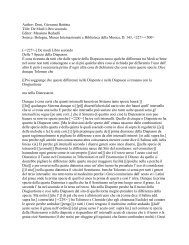
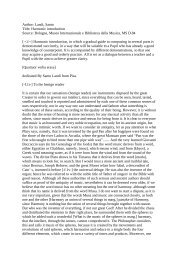
![Doni, Giovanni Battista Title: Trattato Dei Tuoni o [[Harmonie de]]](https://img.yumpu.com/45461005/1/190x245/doni-giovanni-battista-title-trattato-dei-tuoni-o-harmonie-de.jpg?quality=85)
